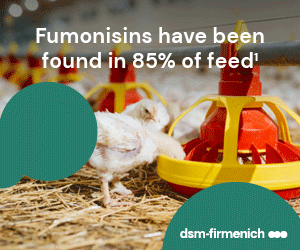



Commentary: December 2007 USDA Hogs and Pigs Report
US - Dr Mike Brumm, Extension Swine Specialist, University of Nebraska comments on the latest USDA Hogs and Pigs report.While the analyst’s commentaries have generally been bearish regarding this report, the item of interest is the continued consolidation of the growing pig inventory in the upper Midwest region of the US. Given the dramatic increase in feed grain prices, along with increased transportation expenses for both weaned and slaughter pigs, it should not be surprising that facilities for growing pigs to slaughter are being located near the source of the feed grains (which increasingly include DDGS and other co-products of bio-fuels production) and slaughter facilities.
The other item affecting the location of growing pigs is the increased number of Canadian feeder pigs entering the US. For the week ending December 22, there were 166,000 feeder pigs entering the US from Canada, the largest weekly total on record. The final 2007 tally of Canadian feeder pigs entering the US will be very close to 6.5 million pigs, up from 5.9 million pigs in 2006. A majority of these pigs end up in Iowa and southern Minnesota facilities. The increased number of Canadian pigs in the US inventory explains in part the growth of the US Kept for Market inventory in Iowa and Minnesota relative to the remainder of the US. Given the current situation in Canada due to the strong Canadian dollar, lack of competitive slaughter plants and high feed grain prices, it is logical to expect the surge of Canadian born pigs to continue, especially pigs from Manitoba and Saskatchewan. The location of pigs born in Manitoba and Saskatchewan relative to northern Iowa and southern Minnesota finishing sites makes transportation of weaned pigs relatively competitive versus transportation of weaned pigs from western Oklahoma to the same sites.
In the US, North Carolina, Nebraska, Missouri, Oklahoma, Illinois and South Dakota are net exporters of weaned pigs, as evidenced by the disparity between their percentage of the breeding herd versus the percentage of the Kept for Market inventory. On the other hand, Iowa and Minnesota lead the nation in importing weaned pigs using the same criteria.
Not in these reports is data regarding ownership of pigs. Of interest is the fact that an increasing number of Canadian feeder pigs are being grown to slaughter in contract production facilities in the US, with the Canadians retaining ownership. As the North American industry (Canada and the US) responds to current economic conditions, it is worth noting that a small but growing percentage of the total production is in the hands of Canadian owners with farrowing sites in Canada and finishing pigs in the Midwest. This means their decision process is influenced by such global issues as the currency exchange rate, in addition to local issues that include feed grain prices, labor, market access, etc. In the past, global issues impacted the production decision process in a more indirect manner, usually through their impacts on export markets and the subsequent impact on slaughter prices.
This Hogs and Pigs report included data on the total number of pigs farrowed in the US from December 1, 2006 through November 30, 2007. US producers reported a pig crop of 109.937 million pigs for this period. The latest NAHMS survey of swine health practices, released in October, 2007 suggests an 11% pre-weaning mortality for US producers in 2006 (http://www.aphis.usda.gov/vs/ceah/ncahs/nahms/swine/index.htm). This means an estimated 97.844 million weaned pigs were transferred to nursery or wean-finish facilities. For the same time interval, an additional 6.31 million feeder pigs were imported from Canada for a total of 104.154 million pigs placed in facilities for growth to slaughter with Canadian born pigs representing 6.1% of this total. As a source of weaned and feeder pigs for US production facilities, Canada ranks just ahead of Nebraska and Missouri who had an estimated 6.16 and 6.12 million pigs weaned, respectively and is tied with Oklahoma which weaned an estimated 6.3 million pigs last year.
With Iowa and Minnesota being the main destination for these Canadian born pigs, this suggests that upwards of 9-10% of the Kept for Market inventory in these 2 states was born in Canada. The House of Representatives and the US Senate have passed differing versions of the next Farm Bill. Included in the bills are differing implementations of Country of Origin (COOL) labeling. With such a large concentration of Canadian born pigs in Iowa and Minnesota, the final conference committee resolution of the COOL regulations could have a major impact on the structure of the industry in these states.
It is also interesting to note that Iowa producers weaned an estimated 15.4 million pigs while their December 1 Kept for Market inventory was 17.0 million pigs. As a rough estimate, one can assume that on average it takes just under 6 months to grow a pig from weaning to slaughter. Thus, the Kept for Market category represents the approximate number of pigs (less death loss) that will go to slaughter in each state in the next 5.5-6 months. This suggests that Iowa producers now import more than 50% of the pigs grown to slaughter into their state.
Further Reading
|
|
- To view the full article and graphics, please click here. (PDF 14 pages) |
|
|
- To read the December 2007 Quarterly Pigs and Hogs report, please click here. |
















